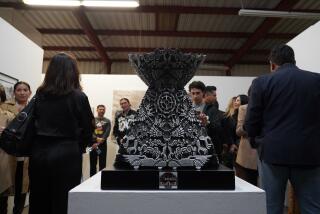RIDE ‘EM, CHARRO : A New Generation Perfects the Mexican Art of Charreria
- Share via
It is considered a supreme test of man’s dominance over animals, yet it is more an interplay of style and beauty than of strength and speed, as much equestrian ballet as rodeo. At lienzos (arenas) across the American Southwest, including regular weekend meetings at the Pico Rivera Sports Arena and the Riverside Charros arena in Colton, hundreds take part in charreria , a popular performance sport that embodies 500 years of Mexican horsemanship, tradition and pride.
Similar to rodeo, it is a contest of specific skills: Two or more teams of at least 15 charros compete in suertes (events) such as individual horse reining, bull and bronc riding and team roping. Using a complex body of rules, judges evaluate charros on details such as the perfection of a lasso throw or whether the charro remembers to slap the steer on the backside before felling it with a twist of the tail. Even the costume--sombrero, chaps, boots, vest, handwoven belt, jacket, shirt with upright collar, snug pants and tie--is painstakingly evaluated. Any imperfection, such as wearing bright colors or forgetting one’s chaps, can lower a score.
At a charreada in Cuyama in Santa Barbara County, the announcer competes with the banda music spilling from a platform above the bleachers. “ Que lastima “ (What a pity!), he cries whenever a charro fails. But when a charro does lasso the legs of a wild mare or perform some other feat successfully, the audience cheers, the music grows triumphant and youths twirl matracas , wooden noisemakers that click festively.
“I like watching because I can remember our roots,” says Angelia Arias, a native of Zacatecas who has lived in California for five years. “It’s a way to ‘be’ in Mexico, because we don’t feel at home in the United States.”
“This is what we love,” explains 18-year-old Isabel Rodriguez, a member of an escaramuza team called Espuela de Oro. The all-female, vibrantly clad escaramuzas do not compete for points but perform complicated equestrian drills between suertes . “It’s like a family thing, it keeps us away from the street,” says Rodriguez.
Manuel Gonzales Jr., a 32-year-old Mexican-born charro from the team Rancho Grande, learned the sport from his father. Now Gonzales is teaching charro skills to his own two sons. “My kids are U.S. citizens, but I would like them to know a little bit about their ancestry and heritage,” he says.
Recently, however, charreria has come under attack from animal rights activists who claim that two of the suertes are abusive. During these events, participants on foot or on horseback throw a lasso and attempt to fell a wild mare by ensnaring its forelegs. A bill to make these two events illegal was recently introduced in the state Legislature.
The charros, however, refuse to bend to the demands of groups they feel have no understanding of the charreria tradition, which began in the Mexican countryside as a way of celebrating ranching skills. “Anybody who knows about animals knows that that’s not cruel,” says Gonzales. “That’s ranch work. That’s part of life.”
More to Read
Sign up for Essential California
The most important California stories and recommendations in your inbox every morning.
You may occasionally receive promotional content from the Los Angeles Times.










